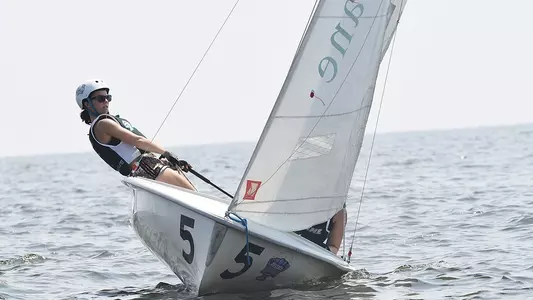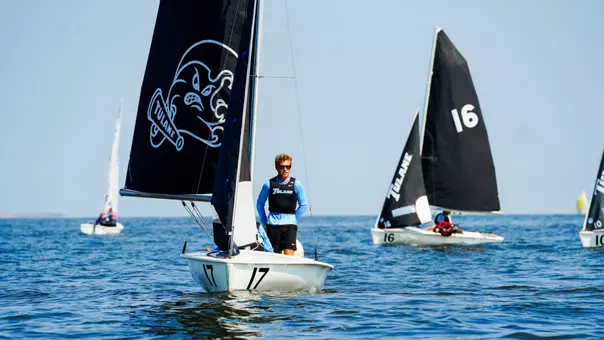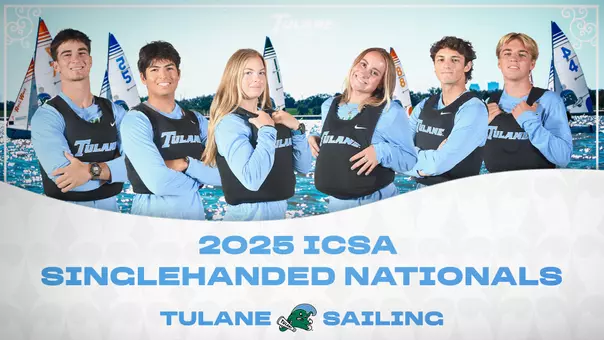
Photo by: Parker Waters
Sailing 101: The Boats and Sailors
Jul 5, 2018 | Sailing
Part 1: Boats/Sailors | Part 2: Regattas/Races (coming 7/5) | Part 3: College Sailing Structure (coming 7/12)
Welcome to Sailing 101! Class is now in session! This is the first of a three-part series intended to educate Tulane fans on the basics of sailing, our newest varsity sport.
Each story in the three-part series will focus on a different aspect of sailing: 1) the boats and sailors; 2) the regattas; 3) the national structure of collegiate sailing and how to win a championship. Parts two and three will be released in each of the next two weeks.
NEW ORLEANS – As the first varsity sailing season begins for Tulane, the team will be acquiring a brand new fleet of boats for their roster of 31 sailors. But how do those boats work? And what do the sailors in the boats do to make them go fast?
Tulane, through a partnership with Community Sailing of New Orleans, Inc., will be acquiring a new fleet of 18 sailboats called the Z420 which is produced by a company called LaserPerformance. Additionally, Tulane will be acquiring a smaller number of singlehanded – or one-person – boats called Lasers to compete in the singlehanded national championships.
The Z420s will help Tulane keep up with the nation's best college sailing programs. The club sailing team's previous fleet was 10 years old and outdated.
"The Z420 is really the standard used across the country now," Coach Charles Higgins said. "Since the Z420 is going to be the boat of choice at not only the national championships, but most of the regattas we will enter, it was important that we match what equipment was going to be used elsewhere."
They each weigh about 220 pounds and are named for their length of 420 centimeters, or about 14 feet. The boats are 5.5 feet wide at the center, and their two sails are hoisted up a mast that stands about 20 feet tall.
The Z420s are doublehanded boats, meaning each holds two sailors. The sailors on board are one of two positions: skipper or crew. The skipper drives and controls the rear sail, or mainsail, while the crew focuses on a variety of important tasks including controlling the front sail, or jib. The boats also have two boards that extend underwater. The first is the centerboard, which prevents the boat from sliding sideways through the water, and the second is the rudder. Positioned at the back of the boat, the rudder is what the skipper uses to steer the boat.
"Boats with multiple sails like the Z420 are designed for the sails, and therefore the sailors, to work in unison," Higgins said. "When that happens, the boat becomes more efficient as it moves through the water. When the wind flows properly over the front sail, it actually provides air flow to the sail behind it and allows it to perform even better."
To sail properly, a sailor first must know where the wind is coming from. But how does a sailor judge this? There is a very low-tech method that sailors use involving attaching a small bit of cassette tape or yarn to a part of the boat and using that like a flag. This method is similar to the orange flags atop goal posts in a football stadium.
Once the wind direction is known, it is important to be able to judge the way the wind is flowing over the sails. Small strings attached to the sails called telltales help the sailors know if their sails are aligned, or trimmed, correctly and judge the smoothness of the airflow coming off the sails. Telltales moving in a wild pattern means the sail isn't trimmed correctly. Telltales keeping a consistent direction means the air is flowing optimally over the sail.
When this is all done properly the boats have the greatest speed potential. When asked just how fast these boats can go, Higgins joked, "Usain Bolt is faster."
The speed of the boat is dictated by the speed of the wind, so unless it is quite windy out, the boats don't move with tremendous speed. To put it one way, they never exceed school zone speed limits. But while it may not seem particularly fast while watching from land, being on a sailboat means there's no shortage of action and fast-paced decision making to make the boat get ahead of the competition.
One of the biggest challenges is that sailboats cannot sail straight into the direction of the wind. Often the boats must race around a buoy in the water that is directly upwind in the distance. In order to get there, the boats will have to sail a zigzag course. Each time they change course, the sails and the sailors themselves must switch sides in the boat. This maneuver when going toward the wind is called tacking, and while going in the same direction as the wind is called jibing.
But to go even faster, sailors must perform the impressive-looking and challenging "roll tack" and "roll jibe" maneuvers. For that, the sailors use the wind and their body weight to tilt the boat to the point where it looks like it is about to capsize. Then, making adjustments to the sails and sliding under the boom to the other side, they re-balance the boat.
This movement of tipping the boat over so far and then rapidly bringing it upright helps to artificially add more wind to the sails and propels the boat even faster. It's pretty intense, and doing a proper roll tack or roll jibe is one aspect of what separates a good sailor from the average sailor.
"We're bouncing around from one side of the boat to the other, we're extending our bodies out over the side," Higgins said. "If you were to get up close you'd realize there's a ton of work going on."
Just like any other sport a tremendous amount of time is devoted to learning and perfecting proper technique, so that the execution in competition is second nature.
Lastly what prevents the boat from just tipping over when the wind picks up? Using straps secured inside the boat, the sailors will place their feet underneath and extend their entire body outside the edge of the boat. The sailors are not merely hanging there either. With a coordinated use of their core and leg muscles, the sailors are actually exerting a massive amount of force to counteract the wind pushing them over. While this is going on, they still must trim the sails perfectly, execute their maneuvers, keep track of the other competitors, and read the ever-changing wind patterns.
Got all that straight? Competitive sailing is no relaxing day on the water. The skipper and crew must constantly communicate with each other, move all around the boat and have a high level of strength and stamina to sail effectively.
Join us next week for our second edition Sailing 101.
Welcome to Sailing 101! Class is now in session! This is the first of a three-part series intended to educate Tulane fans on the basics of sailing, our newest varsity sport.
Each story in the three-part series will focus on a different aspect of sailing: 1) the boats and sailors; 2) the regattas; 3) the national structure of collegiate sailing and how to win a championship. Parts two and three will be released in each of the next two weeks.
NEW ORLEANS – As the first varsity sailing season begins for Tulane, the team will be acquiring a brand new fleet of boats for their roster of 31 sailors. But how do those boats work? And what do the sailors in the boats do to make them go fast?
Tulane, through a partnership with Community Sailing of New Orleans, Inc., will be acquiring a new fleet of 18 sailboats called the Z420 which is produced by a company called LaserPerformance. Additionally, Tulane will be acquiring a smaller number of singlehanded – or one-person – boats called Lasers to compete in the singlehanded national championships.
The Z420s will help Tulane keep up with the nation's best college sailing programs. The club sailing team's previous fleet was 10 years old and outdated.
"The Z420 is really the standard used across the country now," Coach Charles Higgins said. "Since the Z420 is going to be the boat of choice at not only the national championships, but most of the regattas we will enter, it was important that we match what equipment was going to be used elsewhere."
They each weigh about 220 pounds and are named for their length of 420 centimeters, or about 14 feet. The boats are 5.5 feet wide at the center, and their two sails are hoisted up a mast that stands about 20 feet tall.
The Z420s are doublehanded boats, meaning each holds two sailors. The sailors on board are one of two positions: skipper or crew. The skipper drives and controls the rear sail, or mainsail, while the crew focuses on a variety of important tasks including controlling the front sail, or jib. The boats also have two boards that extend underwater. The first is the centerboard, which prevents the boat from sliding sideways through the water, and the second is the rudder. Positioned at the back of the boat, the rudder is what the skipper uses to steer the boat.
"Boats with multiple sails like the Z420 are designed for the sails, and therefore the sailors, to work in unison," Higgins said. "When that happens, the boat becomes more efficient as it moves through the water. When the wind flows properly over the front sail, it actually provides air flow to the sail behind it and allows it to perform even better."
To sail properly, a sailor first must know where the wind is coming from. But how does a sailor judge this? There is a very low-tech method that sailors use involving attaching a small bit of cassette tape or yarn to a part of the boat and using that like a flag. This method is similar to the orange flags atop goal posts in a football stadium.
Once the wind direction is known, it is important to be able to judge the way the wind is flowing over the sails. Small strings attached to the sails called telltales help the sailors know if their sails are aligned, or trimmed, correctly and judge the smoothness of the airflow coming off the sails. Telltales moving in a wild pattern means the sail isn't trimmed correctly. Telltales keeping a consistent direction means the air is flowing optimally over the sail.
When this is all done properly the boats have the greatest speed potential. When asked just how fast these boats can go, Higgins joked, "Usain Bolt is faster."
The speed of the boat is dictated by the speed of the wind, so unless it is quite windy out, the boats don't move with tremendous speed. To put it one way, they never exceed school zone speed limits. But while it may not seem particularly fast while watching from land, being on a sailboat means there's no shortage of action and fast-paced decision making to make the boat get ahead of the competition.
One of the biggest challenges is that sailboats cannot sail straight into the direction of the wind. Often the boats must race around a buoy in the water that is directly upwind in the distance. In order to get there, the boats will have to sail a zigzag course. Each time they change course, the sails and the sailors themselves must switch sides in the boat. This maneuver when going toward the wind is called tacking, and while going in the same direction as the wind is called jibing.
But to go even faster, sailors must perform the impressive-looking and challenging "roll tack" and "roll jibe" maneuvers. For that, the sailors use the wind and their body weight to tilt the boat to the point where it looks like it is about to capsize. Then, making adjustments to the sails and sliding under the boom to the other side, they re-balance the boat.
This movement of tipping the boat over so far and then rapidly bringing it upright helps to artificially add more wind to the sails and propels the boat even faster. It's pretty intense, and doing a proper roll tack or roll jibe is one aspect of what separates a good sailor from the average sailor.
"We're bouncing around from one side of the boat to the other, we're extending our bodies out over the side," Higgins said. "If you were to get up close you'd realize there's a ton of work going on."
Just like any other sport a tremendous amount of time is devoted to learning and perfecting proper technique, so that the execution in competition is second nature.
Lastly what prevents the boat from just tipping over when the wind picks up? Using straps secured inside the boat, the sailors will place their feet underneath and extend their entire body outside the edge of the boat. The sailors are not merely hanging there either. With a coordinated use of their core and leg muscles, the sailors are actually exerting a massive amount of force to counteract the wind pushing them over. While this is going on, they still must trim the sails perfectly, execute their maneuvers, keep track of the other competitors, and read the ever-changing wind patterns.
Got all that straight? Competitive sailing is no relaxing day on the water. The skipper and crew must constantly communicate with each other, move all around the boat and have a high level of strength and stamina to sail effectively.
Join us next week for our second edition Sailing 101.
Tulane Athletics - Tulane sailing to benefit from $2.75 million gift
Friday, October 27
Coach Higgins Sailing Look In
Friday, November 18
2020 Tulane Sailing Season Highlights
Thursday, March 26
Sailing Earns No. 1 and 2 Finishes in Baldwin Wood Regatta
Sunday, October 28













